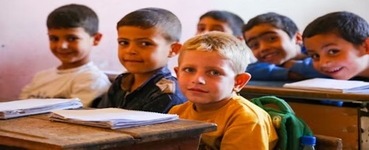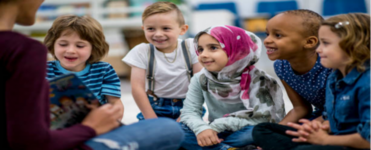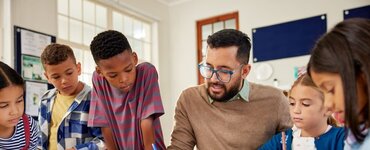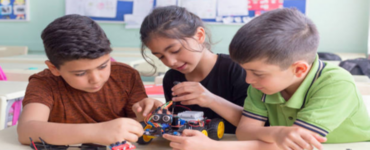Yacoub Aljaffery
The current study highlights the powerful aspirations that refugee students bring with them, emphasizing their resilience, optimism, and hope for a better future. The article advocates for an asset-based approach in education, where the strengths and potential of refugee students are acknowledged and supported to unlock doors of opportunity and success.
Keywords: refugee education, asset-based, inclusive education
Introduction
In reflecting on the experiences of refugee students, it is essential to begin with a deeply personal narrative. When I immigrated to the United States in the mid-1990s, I was confronted with the challenging task of navigating a new culture, language, and educational system. As a refugee, I was burdened by the labels that were often assigned to me: “refugee,” “victim,” “survivor.” Among these terms, the word “refugee” was the one I most resented. It represented a connotation of displacement, fear, and endless struggle to rebuild, reducing my identity to a singular, traumatic event. This term, in many ways, failed to acknowledge the resilience, strength, and aspirations that had driven me to persevere. This sentiment is reflected in the participants in this study, who, despite recounting their struggles, also highlight the powerful assets they brought with them to the classroom. Their stories are filled with cultural wealth, resilience, and an unwavering drive to succeed. Unfortunately, refugee students are often overlooked by the education system. Through this study, I aim to shift the narrative from a deficit-based perspective to one that recognizes the assets these students bring to the classroom. This approach aligns with Yosso’s (2005) cultural wealth theory, particularly the concept of aspirational capital, which underscores the importance of recognizing and valuing the strengths of marginalized students.
Refugee students’ educational aspirations
Research has shown that refugee students often demonstrate high levels of determination and ambition, which drive their academic success (Koyama, 2013). Even when facing educational disruptions and limited prior schooling, they remain committed to higher education and career advancement, often motivated by their families’ sacrifices and the desire to create better futures (McBrien, 2016). This perseverance enables them to succeed in academic environments despite systemic challenges.
Overcoming barriers through determination
Studies indicate that refugee students’ strong future-oriented mindset helps them navigate challenges such as language barriers, unfamiliar schooling systems, and social exclusion (Shapiro & MacDonald, 2017). Their resilience allows them to adapt and excel in new academic settings (Dryden-Peterson, 2017). Moreover, educators who recognize and support these aspirations play a crucial role in fostering success, highlighting the importance of an asset-based approach in education (Naidoo, 2018).
Data collection and participants
This study employed a narrative inquiry approach, using in-depth interviews to explore the experiences of refugee students. Five college students participated, each completing two interviews—the first lasting about 90 minutes and the second 30 minutes. The interviews encouraged them to reflect on their high school experiences in the United States, both in and outside of school, shaping how they understood their educational journeys. The participants are:
- Naeema (19, female, Somalia) – Lived in an Ethiopian refugee camp for five years before resettling in the United States as a high school student.
- Kwa Lah (19, female, Burma) – Spent her childhood in Thai refugee camps and arrived in 10th grade.
- Moses (18, male, Burma) – Schooled in Thai refugee camps before arriving in the United States in 10th grade.
- Htoo (22, male, Burma) – Fled through forests and rivers to refugee camps in Thailand before resettling and starting 9th grade in the United States.
- Napoleon (19, male, Burma) – Born in a Thai refugee camp and placed in 9th grade upon arrival in the United States.
Focusing on college students allowed for deeper reflection on their educational trajectories. All arrived in the United States with minimal formal education, having attended only basic literacy programs in refugee camps. Despite these challenges, their narratives highlighted resilience, hope, and agency.
For analysis, I transcribed interviews verbatim and conducted thematic analysis, identifying recurring patterns through an asset-based lens. I focused on how they framed their experiences positively, often contrasting their current opportunities with past educational limitations in refugee camps. They also emphasized a sense of freedom compared to past oppression. By centering their resilience, optimism, and agency, I identified key themes that illustrate how they navigated challenges and leveraged their strengths to adapt and thrive. These themes form the basis of the study’s discussion and findings.
Findings and discussion
The students’ hope and determination for a better future are deeply tied to their resilience and their ability to see the possibilities that lie ahead. These students have lived through hardships that many of their peers in the United States could not even begin to imagine, yet it is their ability to dream of something better, to see the opportunities around them, that becomes one of their most powerful assets. Despite the challenges they have faced, their stories are filled with hope—hope that not only fuels their academic success but also propels them forward as they continue to carve out better futures for themselves and their families.
Education as a pathway to dreams
While these refugee students are motivated to pursue education for better job opportunities and financial stability, they also see education as a way to honor their families’ sacrifices and give back to their communities. Beyond personal success, education represents a means to support those still in refugee camps, gain respect, and create opportunities for others.
Most participants in this study viewed education as a pathway to securing good jobs and gaining respect within both society and their communities. For example, Htoo saw education as more than just a means of personal success; for him, it was a source of honor and recognition. His reflections highlight the deep significance he places on education, shaped by his personal experiences and cultural background. He believes that education not only provides a future but also elevates one’s status within the community. His words capture this sentiment:
“Education is very important to me. It’s gonna have your future. In my culture, if you have education, if you know that thing [have knowledge], people gonna respect you. They gonna put you on top.” (Htoo, from Burma).
Participants also spoke about how education in this country represents more than just personal success; for many, continuing their education is a way to honor their parents’ sacrifices. Rather than focusing solely on social status, they view education as a means of repaying the hardships their families endured. Moses, for example, sees his education as a tribute to his parents’ resilience. Having grown up in a refugee camp where survival took precedence over schooling, he now recognizes the opportunities available to him and is determined to succeed—not just for himself, but for his parents, who never had the chance to receive an education.
“In the refugee camp, we think about living, food, and water but don’t think about education because we don’t have the opportunity. In America, there is more hope and more education. So, I want to complete my education, so my parents can become proud of me and happy because they didn’t go to school in our home country. I want my parents to smile at my graduation.” (Moses, from Burma).
The students’ deep connection to education extends beyond their own aspirations. They recognize that their education has the potential to benefit not just their families but entire communities. Many envision using their knowledge to give back to the very people who shaped their journey—fellow refugees and those still living in camps. Naeema, for example, shared, “I want be in medical in X-ray or a nurse because I want go back to refugee camp and help refugee children and women because there is no doctors and no medical [services] in the camp, um, so I need to finish education” (Naema, from Somalia).
This forward-looking vision reflects the aspirational capital these students bring, viewing education as a bridge to uplift others. Their perseverance, despite immense hardship and societal underestimation, underscores the resilience that defines them. For these students, education is not just an opportunity—it is a lifeline. Educators must recognize this powerful asset, fostering learning environments that validate their aspirations and ensure they thrive.
Embracing opportunities and freedom
All of the participants spoke with awe about how their lives have changed since coming to the United States. For many, the most profound aspect of this change was the simple fact that they now had legal documentation—something that, for most, had never been part of their lives before arriving in the United States. Many of them had been stateless, with no legal identity. They carried no passport, no birth certificate, no official record of their existence. So, when they arrived in the United States and were handed their first legal documents, it symbolized more than just paperwork—it symbolized their official recognition as people worthy of rights, opportunities, and a future.
“When we come here, we come with no documents. We don’t have an ID card or anything, but we come with a blue bag from the IOM from UNHCR, and this is like our passport. They open it and give us an I-94 card. It was my first document in my life. So, when we were in Thailand refugee camp, we didn’t have documents or passports or anything. First time to have a passport. It’s so nice, yea, so this is my country forever. So, I think I have to accept everything, even if it’s hard, you know.” (Moses, from Burma).
For these students, the United States was not just a country—it was a place where they could finally be free to express their identities without fear. In their countries of origin, expressing their language, culture, or religion could be a dangerous act. But in the United States, they discovered a place where diversity is celebrated and protected. This freedom, which many had never experienced, was a source of immense pride.
“In Thailand refugee camp, we only have Buddhists and Christians, but here we have a lot, any language, many religions. When I came here, I was wowed—there are many religions, and they are different. So, it’s very nice. No one says anything if you go to church or a different place, and I always feel that the U.S.A. is a better place for us because we can be what we want to be, you know.” (Kwa Lar, from Burma).
Moreover, many of these students reflected on the material opportunities they now had access to in the United States, things they had never dreamed of while living in refugee camps. For example, several students marveled at the ability to own property—a fundamental aspiration they had never even considered in their former lives. To them, buying a house was not just about having a roof over their heads; it was about securing their future and claiming their place in a society that they now saw as a land of possibility.
“I’m lucky we came here, uh, a lot of education, a lot of freedom, yea and then you can like, as long as you work, you can buy a car, you can buy a house. We bought a house, and this is the first time we have a house. We actually own it because in the refugee camp, we didn’t have the chance. You cannot buy anything.” (Napoleon, from Burma).
Although there may be differing perspectives on whether refugee students fully receive their rights in the United States, and despite the systemic challenges they face, these students maintain a remarkably positive outlook. They focus on the opportunities available to them, viewing milestones such as homeownership, car ownership, and the ability to practice their religion freely with profound gratitude and hope. This forward-looking perspective serves as a source of resilience, motivating them to persist and strive for greater achievements. Unlike communities where such privileges are often taken for granted, the students in this study brought it back to their amazing outlook on life.
Conclusion
In conclusion, refugee students bring with them strong aspirations, including a hopeful vision for education and a deep appreciation for the opportunities now available to them, particularly when compared to the limited resources they had in refugee camps. Their positive outlook on life and education serves as a powerful source of motivation. These students view education not only as a means of securing better opportunities and social mobility, but also as a way to honor their families’ sacrifices and give back to their communities, which drives their success (Wright, 2021). Beyond individual goals, refugee students carry a profound hope for a better future and a desire to contribute meaningfully to society (Smith, 2020). Research has shown that when educators adopt an asset-based approach, recognizing the strengths and aspirations of these students, it significantly enhances their academic and personal success (Jones & Wang, 2019). Validating and nurturing these aspirations plays a critical role in fostering resilience and achievement among refugee students (Brown, 2021).
How can educators support refugee students in identifying and pursuing their goals?
As a former refugee and English language learner (ELL), and through my work with refugee students, I have consistently observed one key factor that supports refugee students’ aspirations: the presence of a mentor. Having a mentor, or ideally, a network of mentors, can make a profound difference in helping refugee students articulate their aspirations and take meaningful steps toward achieving them.
Mentor matching and goal mapping
Pair refugee students with mentors who share similar backgrounds or career interests to develop actionable academic and career goals. Mentors and students can create vision statements that guide the students’ aspirations and future steps.
Career exploration opportunities
Organize events where mentors who are local professionals share their career paths, emphasizing the importance of education, perseverance, and community engagement. These workshops give students tangible examples of how education can shape their future.
Cultural sharing and reflection
Organize events that encourage students and mentors to engage in cultural exchange activities that involve sharing personal stories, traditions, and values. These interactions not only acknowledge the cultural wealth refugee students bring but also promote mutual respect and deeper understanding.
Additional resources for teachers
Manning, M., Orozco Sahi, I., Juelke, L., & Monterrey, S. (2022). Creating a sense of belonging for immigrant and refugee students: Strategies for K-12 educators. Routledge. https://doi.org/10.4324/9781003139021 (ISBN: 978-1-032-00008-4)
This book offers practical strategies for K–12 educators to support immigrant and refugee students by creating classrooms that foster safety, respect, and belonging. Drawing on their own teaching experiences, the authors highlight the strengths and resilience of multilingual learners and provide tools to help educators affirm student voices, respond to cultural backgrounds, and build inclusive learning environments.
Lander, J. (2022). Making Americans: Stories of historic struggles, new ideas, and inspiration in immigrant education. Beacon Press. ISBN: 9780807013359
In Making Americans, Jessica Lander explores the history and present of immigrant education in the United States. Through powerful storytelling, she highlights both longstanding challenges and innovative efforts to support immigrant students. Drawing on visits to classrooms and communities across the country, Lander showcases inspiring educators and programs that help newcomers thrive while confronting systemic barriers. The book calls for a deeper commitment to reimagining education that fully embraces immigrant students as essential to the American story.
References
Brown, A. L. (2021). Fostering resilience in refugee students: An asset-based approach. Journal of Educational Psychology, 113(3), 466–478. https://doi.org/10.1037/edu0000356
Dryden-Peterson, S. (2017). Refugee education: Education for an unknowable future. Harvard Educational Review, 87(3), 382–387. https://doi.org/10.17763/1943-5045-87.3.382
Jones, D., & Wang, J. (2019). Understanding the impact of asset-based approaches on refugee students’ success in school. Educational Review, 71(2), 237–249. https://doi.org/10.1080/00131911.2018.1500384
Koyama, J. (2013). Resettling notions of social mobility: Locating refugees as “educable” and “employable.” British Journal of Sociology of Education, 34(5–6), 947–965. https://doi.org/10.1080/01425692.2013.816033
McBrien, J. L. (2016). Educational needs and barriers for refugee students in the United States: A review of the literature. Review of Educational Research, 75(3), 329–364. https://doi.org/10.3102/00346543075003329
Naidoo, L. (2018). Developing an inclusive education framework for refugee students in Australian schools. International Journal of Inclusive Education, 22(11), 1195–1213. https://doi.org/10.1080/13603116.2017.1412514
Shapiro, S., & MacDonald, M. (2017). From deficit to asset: Locating the aspirations of refugee students in resettlement discourses. Journal of Literacy Research, 49(4), 448–472. https://doi.org/10.1177/1086296X17726958
Smith, R. K. (2020). The aspirations of refugee students and their role in academic success. International Journal of Refugee Education, 32(1), 48–61. https://doi.org/10.1080/13803611.2019.1678120
Wright, P. (2021). Education as a pathway to social mobility: The experiences of refugee students. Journal of Refugee Studies, 34(4), 529–543. https://doi.org/10.1093/jrs/feaa084
Yosso, T. J. (2005). Whose culture has capital? A critical race theory discussion of community cultural wealth. Race Ethnicity and Education, 8(1), 69–91. https://doi.org/10.1080/1361332052000341006
